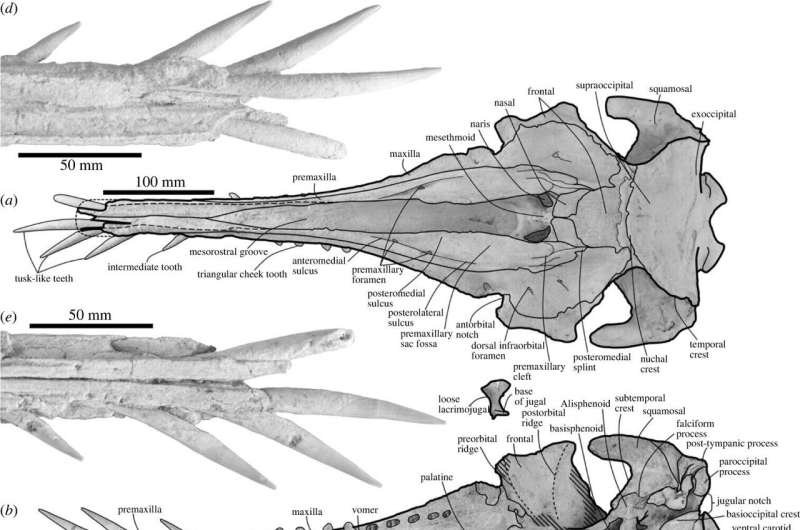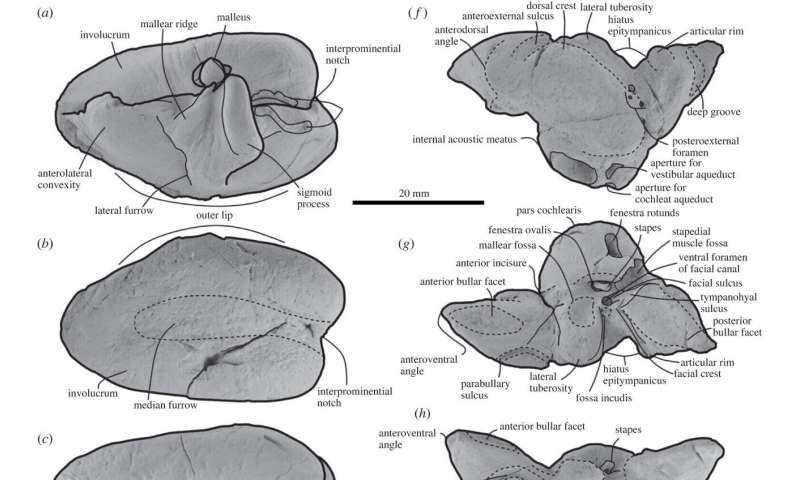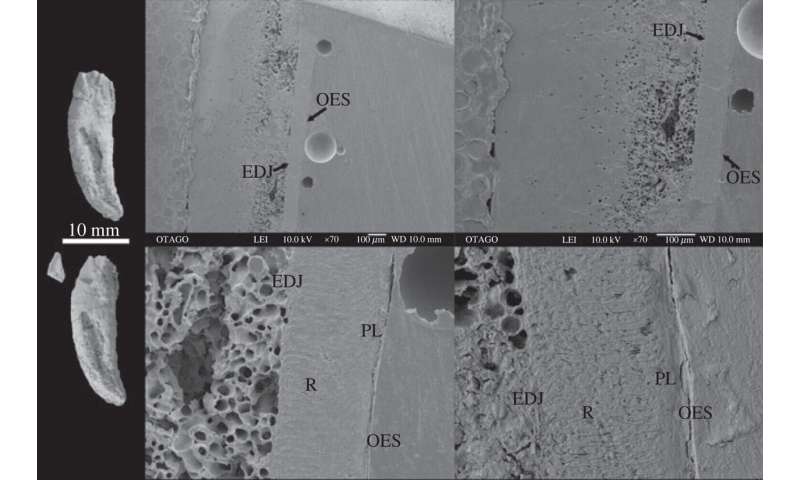June 15, 2023 report
This article has been reviewed according to Science X's editorial process and policies. Editors have highlighted the following attributes while ensuring the content's credibility:
fact-checked
peer-reviewed publication
trusted source
proofread
Study describes ancient New Zealand dolphin with tusk-like teeth

University of Otago, New Zealand, researchers have described a new genus and species of dolphin from the late Oligocene. In their paper, "A new dolphin with tusk-like teeth from the late Oligocene of New Zealand indicates evolution of novel feeding strategies," published in Proceedings of the Royal Society B, the team describes the toothy fossil features of the 25 million-year-old aquatic mammal and how they were likely used.
The nearly complete skull of what the researchers have named Nihohae matakoi (pronounced nee-ho-ha-eh ma-ta-koy) was found with twenty-one teeth in place and another twenty-one detached. Several long teeth are positioned horizontally, including all incisors and canines, which would have given the dolphin a strange outcropping of tusk-like teeth at the front of its mouth.
Skull morphology and excellent preservation of the skull and mandibles provide some insights for the researchers into inferred feeding behaviors of the species. A long flattened face, unfused cervical vertebrae, and a lack of wear on the teeth suggest to the researchers that the tusk-like teeth were used to injure and stun prey through swift lateral head movements.
The lack of significant enamel wear on the other teeth suggests it did not process abrasive prey or use its teeth to find prey in the sandy substrate. The teeth are also too thin and gracile to be used to process large prey.
The original fossil find occurred in 1998 from a fallen block below the face of a cliff in North Otago, New Zealand. It was dated using foraminifera and strontium isotopes as being 25.2 million years old, from the upper Duntroonian age (lower Chattian).
-

Credit: Proceedings of the Royal Society B: Biological Sciences (2023). DOI: 10.1098/rspb.2023.0873 -

Credit: Proceedings of the Royal Society B: Biological Sciences (2023). DOI: 10.1098/rspb.2023.0873
The researchers have named the dolphin Nihohae matakoi (pronounced nee-ho-ha-eh ma-ta-koy). They used the Māori language, "Niho" for teeth and "Hae" for slashing, for the genus and "Mata" for face/point and "Koi" for sharp, in reference to the long, flat and thin face ending in pointed sharp teeth for the species.
Only the male narwhal has a tusk feature among living relatives, with its long unicorn-like "horn" that is actually a highly modified left canine tooth erupting as an ever-growing tusk. It has been suggested that narwhal's use their tusk in hunting, to open breathing holes in the ice, as a defense against predators, or for sexual display. The narwhal's tusk is also likely used as a sensor as it is covered in millions of sensitive nerve endings.
More information: Ambre Coste et al, A new dolphin with tusk-like teeth from the late Oligocene of New Zealand indicates evolution of novel feeding strategies, Proceedings of the Royal Society B: Biological Sciences (2023). DOI: 10.1098/rspb.2023.0873
Journal information: Proceedings of the Royal Society B
© 2023 Science X Network




















